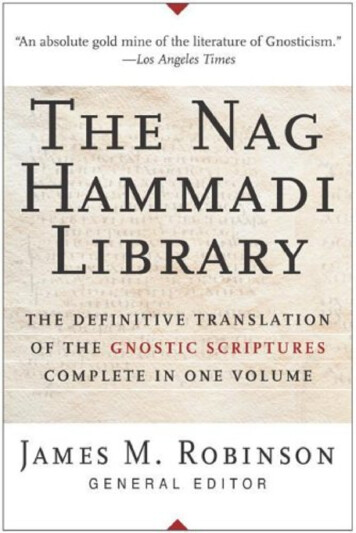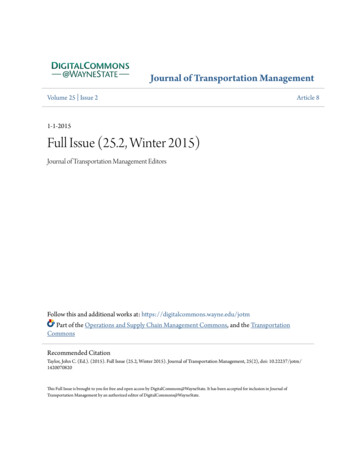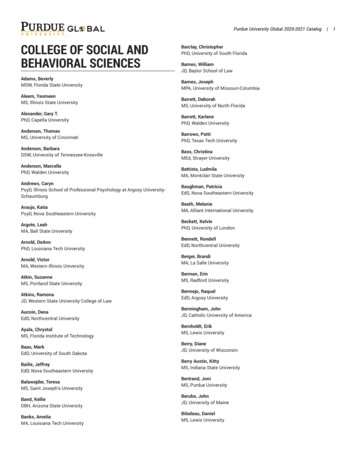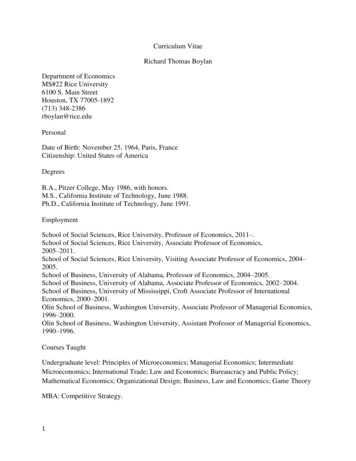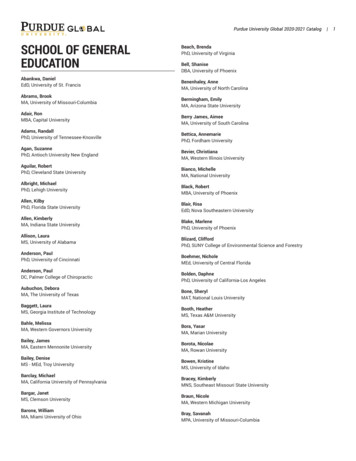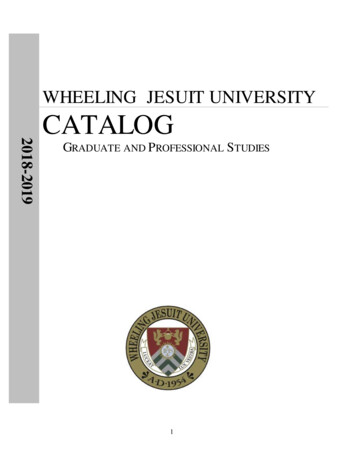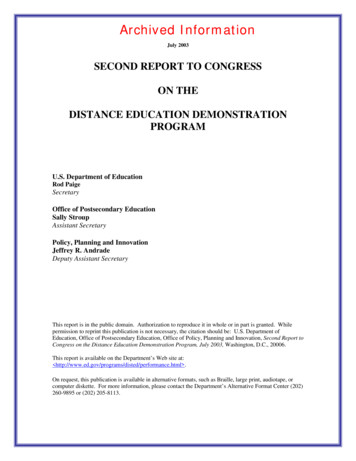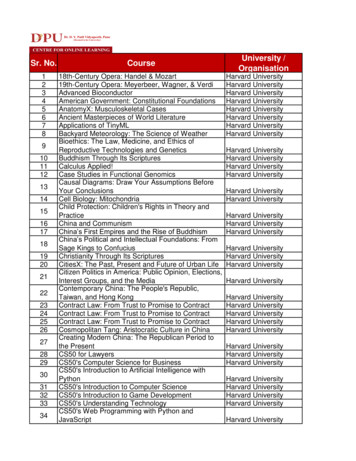
Transcription
CONTENTS0 Oxford University Press 1960ABBREVIATIONSpage viiINTRODUCTIONixI. I N T H E B E G I N N I N GI11. T H E F A T H E R A N D M O T H E R : T H E A L P H A B E T12111. ADAM KASIA, T H E S E C R E T O R H I D D E N ADAM211%'. ADAM A N D H I S S O N S34v. MSUNIA KUSTA: T H E W O R L D O F IDEAL COUNTERPARTSVI. T H E S O U LVII. PERSONIFIED E M A N A T I O N S A N D 'UTHRASVIII. M Y S T E R I E S A N D T H E GREAT M Y S T E R YIX. T H E LANGUAGE A N D I D I O M O F N A S I R U T H AX. T H E B A P T I Z E R S A N D T H E S E C R E T ADAMPRINTED I N AEAN SOURCES"4INDEX"7
iABBREVIATIONSA-NARRARZATSCPDAGRHJAnte-Nicene.Alma RiSaia Rba, Bodleian Library MS. DC 41.Alma Ri5aia Zuta, Bodleian Library MS. DC 48.A@ Trisar & ialia,trans. E. S. Drower. (Published 1960 bythe Institut fiir Orientfonchung, Deutsche Akademie derWissenscbaften, Berlin, under the title rorz Questions.)The Canonical Prayerbook of the Mandaeans: Text, notes,and translation by E. S. Drower (E. J. Brill, Leiden, 1959).Diwan Abafur, trans. E. S. Drower, Studi e Testi, 151, 1950.G n z a Rba, trans. M. Lidzbarski (Gottingen, 1925). GRr(right side); GRI (left side).Clmentine Hatilies and Apostolic Constitution,A-N Christian Library, vol. 17 (Clarke, Edinburgh, 1870).M. Jastrow, Dictionary of the Targumin, Talmud Babli, MC.(Pardes, New York, 1950. 2 vols.).DarJohannesbuch der Mandiie*, trans. M. Lidzbarski (Topelmann, Giessen, 1915, 2 vols.).J m m l of the Royal Asiatic Society.Marbuta &Hibil-Ziwa, trans. E. S. Drower, Studi e T e d ,176, 1953.Manibkche Liturgien, trans. M. Lidzbarski (Berlin, 1920).E. S. Drower, The Mandaeans of Iraq and Iran (ClarendonPress, Oxford, 1937).T. Noldeke, Mandiiische Grammatik (Halle, 1895).Old Testament.Sarb &Quabin d-&lam-Rba, trans. E. S . Drower. Biblica etOrientalia, no. 12 (Pontiiicio Istituto Biblico, Rome, 1950).Vendidad.E. S. Drower, Water into Wine (J. Murray, 1956).Zeitschriften der Deutschen Margenlandkchen Gesellschnjt.Note. The capital letter at the beginning of a word is a convention denoting a deity or god-like quality.
NOTEINTRODUCTIONTHEMandaic letter corresponding to the Hebrew Y andBY the rivers of ‘Iraq and especially in the alluvial land of Al-ArabicKhaur where the Tigris and Euphrates squander their waters inthe marshes, meeting and mating at Qurnah before they flowinto the Persian Gulf, and in the lowland of Persia along theKarun, which like its two sister rivers empties into the Gulf,there still dwells the remnant of a handsome people who callthemselves Munduiiu, Mandaeans (‘gnostics’), and speak a dialect of Aramaic. When the armies of Islam vanquished theSassanids they were already there and in such numbers that theQur’Hngrantedthem protection as ‘peopleof a book’, calling them‘Sabaeans’. To that name they still cling, both in its literary formand as the vernacular q-Subbu, for it ensures their existenceas a tolerated community. The word (from SB’, Syriac ua )Jmeans ‘submergers’ and refers to their baptism ( m q h t u ) andfrequent self-immersion. I n the ninth book of his Fihrist ul‘ulzim, Al-Nadim, who wrote in the tenth century, calls themul-Mu&tasiluh, ‘the self-ablutionists’.I chose none of these names when writing of them in this bookfor, though this may appear paradoxical, those amongst the community who possess secret knowledge are called NqruiiuNqoraeans (or, if the heavy ‘s’is written as ‘z’, Nazorenes). Atthe same time the ignorant or semi-ignorant laity are called‘Mandaeans’, Mmduiia-‘gnostics’. When a man becomes apriest he leaves ‘Mandaeanism’ and enters tumidutu, ‘priesthood‘. Even then he has not attained to true enlightenment, forthis, called ‘Neirutha’, is reserved for a very few. Those possessed of its secrets may call themselves Nasoraeans, and ‘Nqomean’ today indicates not only one who observes strictly allrules of ritual purity, but one who understands the secret doctrine.When the head priests of the community learned some yearsago that two of their number had permitted certain scrolls toe is transliterated by an inverted comma above theline, facing left. The first letter of the alphabet is transliterated by ‘a’.ACKNOWLEDGEMENTST H E author would like to express gratitude to scholars whohave helped her by various suggestions and corrections. Amongstthese she names Professors H. Chadwick, E. R. Dodds, G. R.‘Driver, P. Kahle, A. Momiglino, and R. C. Zaehner. Thelist of helpers does not end there for it includes critical members of her own family, one or two friends, and the kindassistance of Mr. J. Thornton in procuring necessary books.New evidence in Mandaean literature was, of course, themain reason for the helpful patience shown by those whomthe author consulted whilst attempting to relate this hithertounknown material to other gnostic literature, including theKhenoboskin trouwuille.Finally, she would like to thank the staff of the ClarendonPress for their watchful care in shepherding the book throughthe press.
INTRODUCTIONINTRODUCTIONpass into my possession they showed resentment and anger.These scrolls, they said, contained ‘secrets’, knowledge impartedonly to priests at ordmationand never to laymen or to outsiders. Their attitude is understandable. When I was advancedenough in their language to read these documents, I found atintervals stern insistence on secrecy. Only ‘one in a thousandand in two thousand two’ would be found worthy of initiationinto certain mysteries and any initiate who permitted them tobecome public was doomed to punishment in t h i s world andthe next.The scrolls were of two kinds. In such manuscripts as ‘AThousand and Twelve Questions’ (AY Trisar suialia), the.‘Diwan of Lofty Kingship’ (Diwan Malkuta ’hifa),the ‘GreatFirst World’ and the ‘Lesser First World’ (Alma RiSaia Rba andAlma RiiaiaZuta),the teacher who hears and answers questionsis an exalted spirit of light; these manuscripts are placed in theinitiation hut when a novice is prepared for priesthood. Thesecond type of ‘secret’ scroll, in which explanation of the mysteries is more or less incidental, is the Sarh, a composition intended solely to instruct priests in the correct performance ofritual. The word means ‘explanation, commentary’. Instructionusually takes the form of a description of a rite celebrated byspirits in the divine ether-world as a pattern for future priestsin an as yet uncreated earthly world. The proper celebration ofvarious types of baptism, maripta, and Blessed Oblation are described in them. A third type of document provides scatteredsecret teaching, namely a codex containing the canonical prayersand canticles. As these codices are the personal property ofpriests and in constant use, it was many years before I couldobtain a complete copy.Only as manuscript after manuscript is studied does a picturegradually form of an ancient theosophy true to the type we callgnostic, which developed in the syncretistic centuries which preceded the fall of classical paganism. This theosophy was hybrid.It embraced the star-knowledge and wisdom of Babylon andEgypt, the dualism of Iranian sages and Plato, the high specula-tion of the Greeks, and the stem morality of Jewry and itsbook of books. Deeper roots may have reached yet farthereast.If one may venture into hypothesis, seedbeds in whichNeirutha could well have germinated were the flourishing Jewish colonies in commercial towns in Parthia, Media, and Babylonia. These were, of course, in constant touch, not only withone another, but with Jerusalem. I suggest that such a sect mayhave spread into the Jordan valley, Galilee, and Judaea, where itwould naturally have split into sub-sects, one of them possiblyChristianity, which recognized in Jesus its crownedand anointedking-the Messiah. It is a striking fact that in all the Mandaeantexts the word &ha (Messiah, Christ) is only used with thequalification ‘lying’ or ‘false’ of Jesus, and this is the more surprising as every priest is a king (mauta), crowned and anointed,as microcosm of the macrocosm Adam Kasia, the crowned andanointed Anthropos, Arch-priest, and creator of the ccsmos madein his form. The word for the oil of unction is miyu and the verbsfor its application are RSM and ADA. The implication is that theword &ha (the anointed one) was so inextricably connectedwith the hated Jew and Christian that the root MSH was bannedfrom Nasoraean use.Having set foot on the slippery road of speculation, I assumethat it might well follow that after the destruction of Jerusalem,when Jewish Christians for the most part settled in East Jordan,our Nqoraeans, hating, and hated by, both Jew and JewishChristian, would naturally seek harbour in the friendlier atmosphere of Parthia and the Median hills-exactly as the HwanGnoaita relates, and, according to that manuscript ,a number ofthem migrated later under Parthian protection into Babyloniaand Khuzistan. Did they find in the well-watered marsh districtsthere a baptizing gnostic sect like-or affiliated to-their own?It might explain much, but here I can only refer the reader toChapter X of this book.In the ‘secret scrolls’ Jesus and John are unmentioned. Inthe two codices accessible to the uninitiated (GR and DraSia-d-Ixi
xiiINTRODUCTIONINTRODUCTIONYahia) the former is represented as a perverter of Nasoraeanteaching.In contrast, when Jesus appears in the Coptic Christiangnostic manuscripts’ he is used as a mouthpiece of gnosis. Thereis no attempt to represent him as an historical figure, althoughby use of his name the Coptic gnosis is given a Christian aspect.Dr. Gilles Quispel wrote recently? ‘Da13 die Gnosis in Wesenund Ursprung nuht christlich ist wird immer klarer : oh sie abervorchristlich ist, muD noch hewiesen werden.’Nasoraean scrolls of the first type mentioned on p. x exist inthe librariesof head priests and are seldom copied, so that thereis often a gap of several generations between one copy and thenext.T o what date can they be ascribed? The genealogy of eachcomposition is long: and in the colophons it is stated that suchmanuscripts when examined in the Moslem era were alreadyancient, fragmentary, and in places difficult to decipher. It is tobe surmised that the arrival of proselytizing Islam into Mesopotamia and Persia startled Nasoraeans and Mandaeans3 in thosecountries out of sleepy complacency induced by the securitythey had enjoyed during the Seleucid, Parthian, and Sassanianepochs. Reformers, the liturgist Ramuia and his colleaguesset about the task of collecting manuscripts, and, the colophonschronicle, travelledfromplace to place, from priest to priest, andfrom bimundu to bimanda‘ in search of them. The final result wasa heterogeneous, but nevertheless canonical, literature. It shouldbe remarked that the reformers showed little interest in settingtheology to rights although the religion by the eighth and ninthcenturies had become overgrown like a barnacled ship with avariety of contradictory tenets, additions, and legends. Reforming zeal was reserved for and concentrated upon the correct performance of ritual, the meticulous observance of ritual purity,and uniformity in the celebration of baptism and the sacraments.There followed an era of strict observance for priesthood andlaity. Exact directions about the way in which the rites of theNeoraean church were to he performed were inserted in thecanonical prayer book and a certain amount of literary actirityensued in the shape of fur& and such books as the HarunGawa’tu,the Diwun Abutur, and other later compositions.A considerable part of the surviving literature may he datedback to the earliest phases of Nasoraeanism. Most scholars nowaccept Professor Save-Soderbergh’s discovery that the CopticManichaean ‘Psalms of Thomas’ are adaptations, almosttranslations, of early Mandaic hymns,’ not, as was hitherto supposed, vice versa. Al-Nadim’s storyz that Fatik, Mini’s father,belonged to the Mughtasilah sect is thereby strengthened, forthere can be no doubt that this baptizing sect were Sibians, thatis to say Mandaeans and Nasoraeans.Fresh presumptive evidence about the history of the sect cameto light when I discovered and the Vatican Press published theH a r m Guwuitu just mentioned. It purported to be ‘historical’andlrecounted in semi-legendary form how the Nasoraeans fledfrom persecution in Jerusalem and sought refuge in the Medianhills (Turu &Madai) and in Hurun Guwuitu, which I take tomean the city of Harran. Their persecutors were punished bythe destruction of Jerusalem, which would place the flightbefore A.D. 70. I n ‘ H a m ’ they found co-religionists and eventually migrated under a friendly Parthian king, Ardhan (Artabanus), to Lower Mesopotamia where they established headquarters at a place called F b between Whit and Khuzistan.Although this document cannot be accepted as a serious chron-I e.g. in the Codex Askewianus and Codex Bmcianus translated hy CarlSchmidt,Koptirch-GnartircheSchriften (Leipzig, 1905). and in the EvongeliumVm’catir, the first of the Khenohoskion papyri to he published. Judging byaccounts given of the latter by M. Jean Doresse in Livres secrets des gnorriquerd’&ypte (Plon, 1958), what I have said above would hold good for the remainder of these texts.Gnois alr Weltrelipion (Origo Verlag, Zurich, 1951. P . 5).The t w o classes were at that time dearly defined BS separate: theNagoraean belonged to the priestly clan and the Mandaean was a layman.Bimnda bit m n d a , the name of the cult-hut or sanctuary of theMandaeans.’‘xiii’ Targny Slve-SBderhergh, Studies in the Coptic-Mm‘chaean Prolm Book(Uppsala, ‘ 9 4 , p. 128. The author suggests tentatively that the Mandaeanhymns may he placed in the second century A.D. or earlier.a In the Fihrirt-al-‘Ullim, ed. G . Fliigel (Leipzig, 1871-2. z vols.).II’
INTRODUCTIONINTRODUCTIONicle of events, it is of value as confirming oral tradition, for Mandaeans claim that they migrated into their present home fromHarran and before that from Palestine. Most of the re-editedmanuscripts were, according to the colophons, issued from Tib.Dr. Rudolf Macuch’ points out that the sentence referring toHarran could be read ‘in which there me Nasoraeans’, showingthat, at the time at which the writer lived and wrote, Nasoraeans,under that name, were still found in that city. Throughout themanuscript the word ’Nasoraeans’is used, not ‘Sibiya’ (Sabians),and ‘Mandaeans’ are mentioned only once. The point raisedhere is discussed in the Appendix.That Nqoraeans were originally a Jewish group or partlyJewish group is suggested by their claim that John the Baptistwas a member of their sect, and by the fact that the Jordanz isan essential and central feature of their tradition. Today theword yurdna (jordan) is applied not only to running water usedin baptism and immersion, but to any flowing stream; yet theconjunction of John the Baptist and the Jordan is significant.Epiphanius (Adwersus Hnereses, mix: 6) says that there were‘Nqoraeans’ (Nauapaiob) amongst the Jews before the time ofChrist.3 The name could have been applied to any strictlylaw-observing Jewish sect, for the root 7U means ‘to keep, observe, guard’ and could have been used as a laudatory term formore than one group of Jewish dissidents, particularly if theyhad secret teachings.’ Nqoraeans of the Mandaean type ‘keepand observe’ ritual law with zealous fidelity and ‘keep back‘even from their own laity-mysteries considered deep and easilymisunderstood by the uninitiated.NaSoraean hatred for Jews must have originated at a periodat which Nasoraeans were in close contact with orthodox jewryand at a time when the orthodox Jews had some authority overthem. All this points to the truth of the Haran Guwffllatradition.Heterodox Judaism in Galilee and Samaria appears to havetaken shape in the form we now call gnostic, and it may wellhave existed some time before the Christian era. In the SchweichLectures’ given by Dr. Moses Gaster in 1923 on the Samaritans,the lecturer, speaking of settlements of Jews and Samaritansin the Diaspora, mentioned similarities which exist betweenParseeism, Judaism, and Samaritanism, and pointed out thepossibility that Mandaeism might also have sprouted in suchseedbeds.The figure of Pthahil and its connexion as demiurge with theEgyptian god Ptah (see p. 37, n. z), the Mandaean tradition thatthey once had fellow religionists in Egypt: and the apparentlyancientbelieftransmitted by word of mouth that the dove slanghtered before the m @ a is called a ba’ (unsatisfactory thoughthese may be as evidence, for I can find little to justify them inthe texts) must be considered contributory when assessing thepossibility that Nqirutha originated in semi-paganized Jewishcircles.In this book I have tried to view Nasoraean gnosis as a whole,and have not concealed my belief that the secret teaching, basedupon the Mystic Adam, goes back to the first or second centuries. Vitally significant aspects of that gnosis are evident in unpublished scrolls held as a closely-guarded heritage by the innercircle, the Neoraeans. These a layman, however pious, is notallowed to see or hear. They contain tenets imparted only to aninitiated few; indeed, NaSirutha could be called truly esoterica religion within a religion, a gnosis within a gnosis, and its heartis the interpretation which it attaches to sacramental acts.XiV’ R. Macuch, ‘Alter U. Heimat des Mandlismus nach neuerschlossenenQuellen’, Theologische Liternturaeitung (June, I 957).a The Jordan, in contrast to other rivers in Syria and Palestine, is neverreally cold, hence is peculiarly adapted for immersion at all times of the year.Lidzhamki (ML, p. xvii) makes short work of W. B. Smith‘s argumentsin Der vorchr*tltiheJenu (Giessen, ,906) that Epiphanius was mistaken inthis statement.Cf. Isaiah xlviii. 6 and Ixv. 4. nil% ‘secret things’ and O ’ l l grseCretplace*’.‘XV’ M. Gaster, The Somaritom (O.U.P. for the British Academy, 1925).P. 87.* Until recently B mariqta was celebrated once a year for Egyptians drownedwhi1.t chasing Moses and the Hebrews across the yama d-Suf.T h e human-headed bird depicted in Egyptian tombs which representsthe vital spirit, is called the Ba. Seep. 8, n. I .’
INTRODUCTI0,NINTRODUCTIONT o tabulate the principal features of the gnosis :NaSirutha haspreserved for us, as I shall try to convey in the following pages,a complete and coherent gnostic system. Its main features appear in various forms in other gnostic sects and they may beroughly summarized as these:I have not confined my quotations to the secret scrolls alone,for the Ginzu (also called ‘The Book of Adam’, see ‘Sources’)and the liturgical prayers and canticles’ are full of allusions tognosis. One of the scrolls quoted,%a miscellany containing sevenfragmentary books (at the time of writing it was still in pageproof), will I feel certain beregarded as one of the most importantMandaean documents preserved for us in the priestly libraries.The style in which it and other manuscripts quoted are composedis obscure, perhaps intentionally so. The writers seem poorliterary craftsmen: they dilate upon matters repellent to the Western mind, such as the organs and functions of the Body of theSecret Adam. T o a NaSoraean the human body is a replica of theglorious cosmic Body, the holiest of mysteries, and every organin it, including those necessary to digestion, reproduaion, andevacuation, has for him deep symbolical significance and isrevered as an expression of the Divine chemistry of genesis,purification, and catharsis.xviI. A supreme formless Entity, the expression of which intime and space is creation of spiritual, etheric, and materialworlds and beings. Production of these is delegated by It to acreator or creators who originated in It. The cosmos is createdby Archetypal Man, who produces it in similitude to his ownshape.2. Dualism: a cosmic Father and Mother, Light and Darkness, Right and Left, syzygy in cosmic and microcosmic form.3. Asafeatureofthisdualism, counter-types, a world of ideas.4. The soul is portrayed as an exile, a captive; her home andorigin being the supreme Entity to which she eventually returns.5. Planets and stars influence fate and human beings, and arealso places of detention after death.6. A saviour spirit or saviour spirits which assist the soul onher journey through life and after it to ‘worlds of light’.7. A cult-language of symbol and metaphor. Ideas and qualities are personified.8. ‘Mysteries’, i.e. sacraments to aid and purify the soul, toensure her rebirth into a spiritual body, and her ascent fromthe world of matter. These are often adaptations of existingseasonal and traditional rites to which an esoteric interpretationis attached. I n the case of the NaSoraeans this interpretation isbased on the Creation story (see I and z), especially on theDivine Man, Adam, as crowned and anointed King-priest.9. Great secrecy is enjoined upon initiates; full explanation ofI , 2,and 8 being reserved for those considered able to understandand preserve the gnosis.Other features and developments occur in various syncreticand gnostic systems, but the above are, upon the whole, the distinguishing features of Nqoraean gnosis, NaSirutha.rviiMadiiiche Liturgien (see ‘Sources’) contains about a third of thecanonical book. A full and complete edition of the latter is now publishedunder the title of The Canonical Prayerbook of the Mandoems (E. J. Brill,Leiden).a Alj Trisar suiafin (‘A Thousand and Twelve Questions’); see ‘Sources’.
II N T H E BEGINNINGThere was not the non-Existent nor the Existent then;There was not the air nor the heaven which wm beyond.What did it contain? in whose protection?Was there Water, unfathomable, profound7Rig-Veda, X. izg (Macdonell).W HE N a playwright has his plot sketched out, his charactersconceived, and his stage set- ‘Let there be light!’-he takes hisplace, as it were, in the audience while those of whose existencehe is the author work out the play before him. Often, indeed, hispuppets develop in ways hardly intended, but the main plot isunaffected and the dramatist remains the supreme authority.Such, on a cosmic scale, is the Nasoraean concept of Existenceemerging from non-Existence in the beginning. The NaSoraean‘Author of Being’, to use a Western phrase, isExistenceinexceL.It is absolutely without sex or human attribute and in speakingof It the pronoun ‘They’ is used, for Hiiu, ‘Life’, is an abstractplural. Creation is delegated to emanations, and appeals are addressed to It by the two great creative forces which are the firstmanifestation of Itself, namely Mind-the instrument of evocation-and a personification of active Light, Ziwa or Yawar-Ziwa(Awaking, or Dazzling, Radiance). When Yawar is about tocall into existence the ‘ether-world’ and spirits to inhabit it, heapproaches the Author-Spectator as a suppliant, humbly: ‘Ifit please You, Great Life; if it please You, Mighty Lifel’seeking permission to begin his predestined task.We find the ideas which Nasoraean writers try to convey toUS expressed in often contradictory terms. The picture changes,merges, melts before us as they envisage at an ever-fresh anglethe Parpfa Rba, the ‘Great Immanence’ or ‘Great Countena n c e ’ a n epithet applied to the Great Life. Sometimes the6 m8
I N T H E BEGINNINGI N T H E BEGINNINGCause seems to become the Causer or the Causer the Cause; theThinker the Mind or the Mind the Thinker. The Great Life isdescribed as nukraiia, literally ‘alien’, meaning ‘remote, incomprehensible, ineffable’. The word used for ‘Mind‘, mana,‘is not in that sense Semitic but Iranian, suggesting that the wordwas first adopted under Iranian influence. A NaSoraean hymnpraises Yawar-Ziwa, the first Radiance which illumined thestage of existence, and the Mind which produced it:That mystic First Mind [Mam]The glory of Which was transmittedNeither from the uttermost ends of the earthNor from gates within it.For It is Mind, the Great, Mysterious, First,The glory of which was communicatedBy redoublings of radianceAnd by intensification of light. (CP374.)zI worship, praise and laudThe four hundred and forty-four namesOf Yawar-Ziwa son of ‘Radiance-Appeared’,zKing of ’uthras: great Viceregent of shecinahs,‘Chief over mighty and celestial worldsOf radiance, light and glory.(He) who is within the Veil,Within his own shecinah,He, before whom no being existed.Then I worship, laud and praiseThe one great Name which is great,The Name which is powerful.Then I worship, laud and praiseT h e word mana when meaning ‘mind’, ‘thought’, &c., is of non-Semiticderivation: the Aramaic mnna is ‘a garment’, ‘robe’, ‘vehicle’, ‘vessel’,‘instrument’. There is often word-play on the two meanings, and this passedinto other gnostic literature so that ‘robe’ or ‘vessel’or ‘vehicle’ is used as acryptogram for mono meaning ‘mind’ or ‘soul’. For the Zend and Pehlevimeaning of m a w see Nyherg, Die Religionnz der A l t m Iran (Mitteilungender Vorderasiatisch-AWptischen Gesellschaft, Leipdg, 1938), p. 128. Ingeneral, Mona in a cosmic sense is equivalent to the Stoic, Valentinian,and Sethian NoB, ‘the emanation of the Forefather npondrwp’. Reitzensteinpointed out that the Valentinians translated the word mono as ‘vessel’ (itsAramaic meaning, possibly from a Mandaic source) when they made thedying soul exclaim: ‘I a m a precious vessel.‘ The double meaning, Aramaicand Iranian, appears to be used BS a cryptogram in the gnostic ‘Songof theSoul’ (Acts of Thomas) when the Parthian prince meets his ‘robe’. I t issignificant that Parthia is the home of the princely hero. Parthia is mentionedby Hippolytus and Irenaeus as the original centre of the Elkasaite heresy (seeChapter X).Nbay-Ziwa, lit. ‘Radiance burst forth’.An ’uthro is an ethereal being, a spirit of light and Life. ’Uthras werecreated when the ether-world came into being, see Chapter VII.A Ikinta (pl. f k i w t n ) is n ‘dwelling’, ‘indwelling’, ‘shekinah’, ‘sanctuary’.T h e Mandaean cult-hut is called a Ikixta or 6imanda ( biz mnndn).’‘3T h e G (GRr)z Q describes creation as ‘utterance’, or ‘a cry’,‘a calling forth’. ‘Through Thy Word‘ (mimm) says GRr 12,addressing the King of Light, ‘everything came into being’.The first two pages of this book describe Supreme Life, theGreat Life, in mainly negative terms. T h e ‘great Pa&?has‘no associate to share Its Crown nor partner in Its rule’; It is‘light without darkness’, ‘the Life above the living’, ‘Gloryabove glories’, ‘Life without death’, and so on. Such descriptions could be understood even by the uninitiated, but gnosticmetaphor, the ‘mystery idiom’, appears from time to time inGR.This is the Mystery and book of the Radiance which burneth in thepihta‘ which is effulgent in Its own radiance and great in Its light.(GRr 238.)Pihfa here does not mean as usual ‘sacramental bread‘, but‘the opened‘, ‘the revealed’, used in the idiom of such mysteryhymns as 358-9 (CP) which begin, ‘When He opened HisGarment’, referring to the first emanation and the act of creation; and in the word Zbusa, ‘garment’, ‘covering’, ‘cloak’, wehave a typical example of word-play on manu (see p. 2, n. I ), sothat ‘when He opened his 2bu.W really means ‘revealed HisT h e mots PHT, PTH, and PTA mean ‘to open’, ‘to break apart’, and all areused sometimes to describe creative activity. PTA also means ‘to originate’.Lidnharski used the word schuf to translate pta. Pihta (lit. ‘opened‘) is theritual name of the loaf used at all sacred rites. I t may mean ‘somethingbroken apart or into pieces’ (see E. S. Drower, ‘The Sacramental Bread(Pihtha) of the Mandaeans’, ZDMG, Bd. 105,Heft I , 1955, p. X I S , and d.Aramaic kW3). Bread is a symbol of life: the Arabic‘life’ also means‘bread‘ and ‘wheat’.
4I N T H E BEGINNINGI N THE BEGINNINGMind‘ or ‘Thought’. In the first hymn the mmua is mentioneddirectly afterwards:festation of the Ineffable. Evil is depicted as the inevitable concomitant of matter: it appears as it were of itself as the result ofthe dualism which is the first expression of Unity in plurality.This inevitability appears again and again in the secret teaching:For the First Mmd (nonu)began (pta) and dwelt therein.Some words in the mystery-idiom are impossible to translateadequately, such as tuna (Tanna?). Judging by the context insome passages it would seem to mean a matrix, a formativecentre.’ I n the same hymn we hear of a t u r n and it is mentionedin one of the baptismal hymns:The Radiance glowed in great effulgence.The Tonna dissolved and a fkinto came into existenceAnd was established in the House of Life.I n GRr 238: 6 the Tuma is mentioned in a description of thecreation of first things:.and radiance issued from t h e e t a ; light resred on thepihta andproceeded from it. It created an emanation for itself, the radiance andlight which issued from itself. Radiance glowed, the light glowed;the Tanna heated, the Tanna dissolved.The first prayer in the baptismal liturgy, the Book of Souls,begins thus:Other passages in the same scroll confirm the inevitability,the dependence of one upon the existence of the other:0 Vision of ’uthras, 0 Word from whose Mind all kings emanated!Behold! Light and Darkness are brothers; they proceeded from oneMystery and the Body [‘ una] retaineth both. And for each sign inthe’body [pagra]’ that pertaineth to Light there is a correspondingmark of Darkness. Were it not marked with the mark of Darkness itwould not be established nor come forward for baptism and be signedwith the Sign of Life. (ibid., p. 261).YIN:Reveal to me about Radiance [ziwa] and Light [nlnrro]; aboutLight and Darkness, Good and Evil, Life and Death, Truth andError. (ibid., p. 211.).It is sometimes personified.For darkness and light are bound together: had there been no darkthen light would not have come into being. (AT p. 134.)The worlds of darkness and the worlds of light are Body [( urn]’and counterpart: they (complement) one another. Neither can remove from or approach the other, nor can either be separated fromits partner. Moreover
adam kasia, the secret or hidden adam 1%'. adam and his sons 21 34 v. msunia kusta: the world of ideal counter- 39 47 56 parts vi. the soul vii. personified emanations and 'uthras viii. mysteries and the great mystery 66 81 88 '07 appendix 111 "4 "7 ix. the language and idiom of nasirutha x. the baptizers and secret adam epilogue mandaean sources
